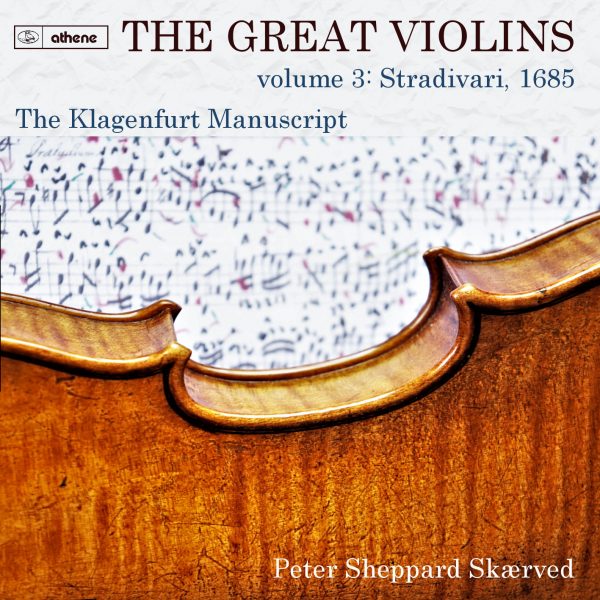Planet Hugill
This disc from violinist Peter Sheppard Skaerved on Athene, The Great Violins: Antonio Stradivari, 1685 – The Klagenfurt Manuscript, explores two areas of violin playing concurrently, he plays a 1685 violin by Antonio Stradivari and performs 96 movements from the Klagenfurt Manuscript, all music by an unknown composer from around 1685 for solo violin.
I have to confess that I had never heard of the Klagenfurt Manuscript until I came across this recording. The manuscript dates from the mid-1680s and was found in the Convent of St Georgen am Längsee in Carinthia, it is now in the collection of the Landesmuseum Kärnten, Klagenfurt am Wörthersee, Austria. The Convent dates from the 11th century but was re-built in the fashionable Baroque style in the mid-17th century, just before manuscript was written. But written by whom?
It is anonymous, as are most of the compositions by Benedictine nuns at the time, and we have to presume that it was written by a nun at the Convent, and the work seems to be a coherent single work by one composer. And, as Sheppard Skaerved explains in one of his articles in the CD booklet, the music is presented in a finely written and expressive hand by a single person whom, for various reasons including the types of error made, Sheppard Skaerved believes to be the composer herself.
One of the distinctive features of the movements is that many are written to be played scordatura, in alternative tunings of the strings. Thanks to his experiments playing the music, including to live audiences, Sheppard Skaerved has come to the conclusion that the reason for the alternative tunings was not just to make different types of musical figurations available, but to bring in different timbres and colours, because with an old instrument like the 1685 Stradivari, different tunings bring different pressures to the strings which affects the instrument’s response and generates new ranges of colour and timbre.
The violin itself is quite a small one, commonly called a violino piccolo nowadays but really dating from a period before violins had become entirely standardised. It is now in the collection of historical musical instruments at the Royal Northern College of Music.
The manuscript includes some music in multi parts, but the majority is for solo violin and Sheppard Skaerved has recorded all the solo music. The movements are almost all dance based, some with the composer’s description but many not (though Sheppard Skaerved has appended the dance movement type to each movement). The music is complex and elaborate, but the dance measures clearly come through. And the movements are all rather short (the first CD has 52 movements lasting a total of 71 minutes). Unlike Bach’s music for solo violin or the Biber Rosary Sonatas (which similarly use scordatura), the music does not seem to have been grouped into suites, or have an optimal playing order.
Sheppard Skaerved uses a modern bow by Antonnin Airento which is based on the type of bow used in Italy and Austria in the mid-17th century and which facilitates the various bowing techniques required by the manuscript.
Sheppard Skaerved has contributed three admirable articles to the CD booklet which help to introduce both the music and the violin, and details his own exploration of the music. They serve to provide the necessary background to this unknown music.
This is a lovely disc, and listening to it continuously makes you realise that for all the dance measures (and some are quite lively and quite catchy), there is something rather concentrated and cumulatively meditative about the music. The disc will not be for everyone, but here we have a lovely intersection between the sacred and the secular, between period performance and modern exploration thereof. Do explore it.
@divineartrecordingsgroup
A First Inversion Company
Registered Office:
176-178 Pontefract Road, Cudworth, Barnsley S72 8BE
+44 1226 596703
Fort Worth, TX 76110
+1.682.233.4978










![Listen to the full suite of Marcel Dupré’s Variations Sur un Noël, Op. 20 from Alexander Ffinch’s #Expectations release today! listn.fm/expectations [in bio]](https://scontent-dfw5-1.cdninstagram.com/v/t51.71878-15/588904367_2327488161082898_8709236950834211856_n.jpg?stp=dst-jpg_e35_tt6&_nc_cat=105&ccb=7-5&_nc_sid=18de74&efg=eyJlZmdfdGFnIjoiQ0xJUFMuYmVzdF9pbWFnZV91cmxnZW4uQzMifQ%3D%3D&_nc_ohc=AiUKMpkx7d0Q7kNvwHPWudW&_nc_oc=AdlSyzKsCKp6NMvVwMod9YXCUKFIsogsRI43RPUGSQEHt0UWfWkm6g7tdmWm5ZMPy6w&_nc_zt=23&_nc_ht=scontent-dfw5-1.cdninstagram.com&edm=ANo9K5cEAAAA&_nc_gid=_T70DZotzYOtohBffu3sKg&oh=00_AfmNPsQKr56W8OpFZZXk58ioLTEQq4YDm33vgDnwohGOsQ&oe=69544FEA)

![“the ‘Manteca’ Paraphrase – a rare foray into the two-piano medium but here played double-tracked – exudes a panache of which Dizzy Gillespie would surely have approved.… [a] recital well worth investigating.” —Gramophone Magazine with high praise for Ophelia Gordon's debut release, Kapustin: Between the Lines!](https://scontent-dfw5-3.cdninstagram.com/v/t51.82787-15/598796470_18303255136283342_540941604740887837_n.jpg?stp=dst-jpg_e35_tt6&_nc_cat=108&ccb=7-5&_nc_sid=18de74&efg=eyJlZmdfdGFnIjoiRkVFRC5iZXN0X2ltYWdlX3VybGdlbi5DMyJ9&_nc_ohc=IC4zZ7tcpb8Q7kNvwHRUk6U&_nc_oc=AdmfzDXPQ2S8NiH6hZVKdY91uywC-vrEOIU3CesaHcIkP_zpIPgPMtJLBuPgR9js4Tw&_nc_zt=23&_nc_ht=scontent-dfw5-3.cdninstagram.com&edm=ANo9K5cEAAAA&_nc_gid=_T70DZotzYOtohBffu3sKg&oh=00_AfkyNHI9_KZm6m2raiS6NSBGctoo1Rk2D1NTfklKpdGcMQ&oe=69542A44)